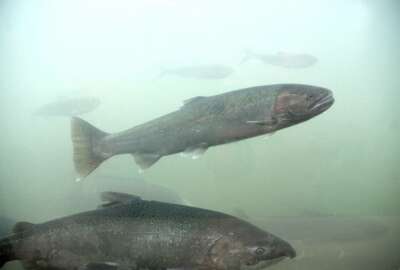
100 years of federal efforts to track and learn more about birds
The pandemic has brought birds back into people's lives. It coincides with the 100 year anniversary of a federal activity aimed at better understanding birds.
Best listening experience is on Chrome, Firefox or Safari. Subscribe to Federal Drive’s daily audio interviews on Apple Podcasts or PodcastOne.
The pandemic, thanks to reduced car, truck and airplane traffic, has brought birds back into people’s lives. You can hear them so much more throughout the day. It also coincides with the 100 year anniversary of a federal activity aimed at tracking and better understanding birds. Bird banding, putting those little tiny bracelets on their feet. With how they’re celebrating, a wildlife biologist with the U.S. Geological Survey, Dr. Jennifer Malpass joined Federal Drive with Tom Temin.
Interview transcript:
Tom Temin: Dr. Malpass, good to have you on.
Dr. Jennifer Malpass: Thanks Tom.
Tom Temin: First of all, I’m surprised that you are the U.S. Geological Survey, I would have expected Fish and Wildlife Service or some other wildlife related agency. Do you do this exclusively at USGS or just one of the agencies that bands the birds?
Dr. Jennifer Malpass: At the USGS, you’re right that a lot of people know us through hazards like volcanoes or earthquakes, but we all have science in other fields like water science, or even ecosystems. Within ecosystems, there are a lot of fish and wildlife researchers who do in depth work on birds, and the Bird Banding Lab (BBL) at Patuxent Wildlife Research Center is one of those. What’s great about USGS is we have so many different large scale and long term data sets — and the BBL, where I work is no exception. So we know that birds are good indicators of ecosystem health and by tracking birds throughout time, we can learn a lot about how to better manage our natural resources by looking at changes in bird populations over time.
Tom Temin: So bird banding, first of all, just to start at the beginning, how do you catch them to put the bands on them?
Dr. Jennifer Malpass: So of course, first, you have to catch the birds, which our researchers do in a variety of ways. You may use a net, you may use a trap that a bird walks into or swims into, or some birds you can even catch by hand. For example, chicks before their wing feathers are grown enough that they can fly.
Tom Temin: Got it. And then what does it tell you? How does it work? So there’s a band on the bird and there’s a number on the band, then what?
Dr. Jennifer Malpass: Right, so each of our birds get a small metal band around their leg that has a nine digit number. And think about that sort of like a bird social security number. It’s unique across all of the birds that we’ve banded throughout the entire hundred year history of the Bird Banding Lab, and we’re able to use that unique number to track individuals. We also have other types of markers that we put on birds, besides the metal band, some folks may put a coded collar on a goose, for example, or there’s eagles out there who are wearing backpacks that have satellite transmitters in them. So they’re able to transmit data about where they are in real time, and we’re able to use that data in a different way than the band being on the bird. But it’s great to have a bird in the hand because we know with wildlife research by studying individuals, if you look at enough individuals, you can help understand the population as well. So when the birds in the hands you can measure things like how long its wing is or how heavy it is, if it’s male or female, a young bird or an adult bird, and you can look at things like body condition as well.
Tom Temin: But once it’s banded in presuming there’s no electronic way of tracking it, I guess maybe that’s coming more and more into the fore, it’s got this nine digit number on it, there has to be like another end from where it’s released that you can check all these facts. So how do you know where to find the bird at the other end to get some indication of where it’s been and what it’s been through?
Dr. Jennifer Malpass: Right, so that first banding of the bird gives us some information about the bird, the age or the sex of the bird. But we get a lot of data if we’re able to get the bird to be reencountered. And often what happens is people may report a bird to us that they’ve encountered through activities like bird watching or hunting.
Tom Temin: And then what happens, you know the bird went from point A to point B, but what else does that tell you about the environment or about the bird population or anything else?
Dr. Jennifer Malpass: So by having an encounter report on a bird, we can look at things like what’s the minimum age that the bird lived to? Where did it move between the ending and encounter, which can tell us about what habitats birds are using, migratory pathways, consider conserving if that bird is a species of conservation concern.
Tom Temin: And this is tracked over years I imagine, you must have a lot of data over the century about birds.
Dr. Jennifer Malpass: So the Bird Banding Lab hosts the largest database of bird banding information. We have over 77 million records spanning back to 1914 — actually, before our lab was even established. So we’re celebrating our centennial here in 2020. And in addition to those 77 million bandings, we have 1.2 million new banded birds in North America every year. And every year we have 80 to 100,000 encounters of those banded birds. So over time, we’ve been able to accumulate over 5.1 million encounters of banded birds and that can tell us information about how old birds are or where they’re moving.
Tom Temin: And what’s ahead for this program? Could there be maybe radio enabled and Internet of Things types of technologies that are now maybe cheap enough and light enough to put on all the birds that are banded?
Dr. Jennifer Malpass: So most of the birds in our database, and most of the birds today, 100 years after the formation of our office, are still banded with that metal leg band. But we know that we’ve seen great advances so we do have birds out there who are wearing different devices that can transmit data so we don’t actually have to see the bird again or capture the bird again to be getting more information about what’s going on with the bird through its life. So there are satellite transmitters, there are for smaller birds what are called archival tags, so they record information and you capture the bird a second time and you’re actually able to download that information off of the tag that the birds been wearing for the last year.
Tom Temin: And ultimately in terms of the ecosystem, what kinds of information does it ultimately yield? Is it only about the birds or is it also about maybe other environmental elements?
Dr. Jennifer Malpass: We know that birds are great indicators of environmental health. And so we can look at changes to help understand and inform questions related to land use change, or environmental contaminants or effects of activities that people are doing, expanding urban areas or even something like the oil spill.
Tom Temin: And when you enlist people to do this on behalf of USGS, what kind of person is best suited to bird banding?
Dr. Jennifer Malpass: So the bird banding lab works with over 10,000 permitted banders across North America. And a lot of our folks have some sort of biological background. I actually got my start bird banding through some community science where there were people who were perhaps in retirement and really wanted to get more involved with the science and had come through different programs than biology. But we know a good bird bander will have great attention to detail. We want to see that they have concern for bird safety and bird welfare. Very important, they need to be trained and permitted to do so. So an important role of the bird banding lab within the U.S. is that we manage all of the permitting of studies in the U.S. and trust territories.
Tom Temin: Because you want people that are going to be nice to the birds.
Dr. Jennifer Malpass: Right. So actually the Migratory Bird Treaty Act that established our office in 1920 to protect our migratory birds across North America. And so we want to make sure that if we’re engaging in activities that would be affecting migratory birds, we want to do that in a safe way for the birds.
Tom Temin: Briefly tell us about the 100 year celebration. What is USGS doing? Making little cakes for the birds maybe or what?
Dr. Jennifer Malpass: Our office has planned a variety of events throughout the year. Many of the events will be virtual. So your listeners who are anywhere across the country can join us remotely to celebrate 100 years of the Bird Banding Lab.
Tom Temin: Are there events that you’ll be attending that people will be having? I mean, it was just sort of a announcement that we’ve been doing this 100 years.
Dr. Jennifer Malpass: Well so the announcement kicks off our centennial and we encourage people to visit our website to learn more about the events that are planned throughout the rest of the year.
Tom Temin: Dr. Jennifer Malpass is a wildlife biologist with the U.S. Geological Survey. Thanks so much for joining me.
Dr. Jennifer Malpass: Thank you for having me.
Read more information about their work here.
Copyright © 2024 Federal News Network. All rights reserved. This website is not intended for users located within the European Economic Area.
Tom Temin is host of the Federal Drive and has been providing insight on federal technology and management issues for more than 30 years.
Follow @tteminWFED





